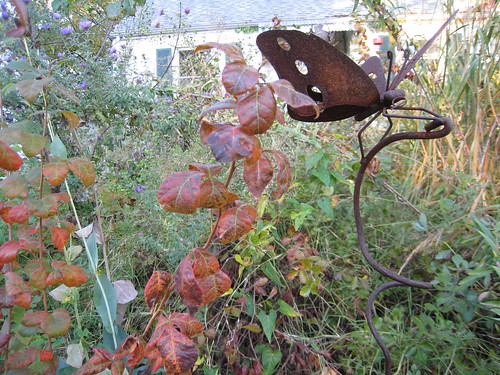 |
| Fragrant Sumac shows great fall color AMcC |
If there were a triathlon of Midwestern native plants, Fragrant Sumac (Rhus aromatica) would be in the winner’s circle.
In the first leg of the triathlon, Wildlife Use, sumac’s performance is outstanding. Fragrant Sumac is one of the earliest blooming plants in our area (Midwestern US). Small yellow flowers appear in March, which, according to the US Forest Service, are pollinated by native bees. The red, hairy little red fruits are gobbled up by mockingbirds and others, since it is one of the first fruits available in summer. Caterpillars of the Red-banded Hairstreak eat fallen, decomposing sumac leaves (Brock and Kaufman, Butterflies of North America). I have seen this butterfly in my yard, but have never observed the caterpillar among the leaf litter.
Sumacs are host plants for two spectacular moths, both with outlandish caterpillars. The Showy Emerald Moth (Dichorda iridaria) caterpillar mimics a crumpled, dead sumac leaf. I haven’t seen this caterpillar yet, and I was unable to find a photo of one online, but nature-lovers should get a copy of David Wagner’s Caterpillars of Eastern North America just to see it. The adult Showy Emerald moth is beautiful. According to ButterfliesandMoths.org (hosted at Montana State University), its range centers on Missouri.
 |
| Hickory Horned Devil, photo by Tom Woodward |
The startling Hickory Horned Devil can be almost 5 inches long! ButterfliesandMoths.org lists its food plant is “sumac.” It’s the larva of the Royal Walnut Moth, also known as Regal Moth. I haven’t seen these on my plants yet, but I’ve seen the adult moth nearby.
Fragrant sumac is a contender in the Garden Use leg of the competition. It’s a small shrub, drought-tolerant, native to glades and prairies. Dave Tylka recommends it as a good shrub for the understory of your wildlife garden (Native Landscaping for Wildlife and People). More than 10 years ago I purchased several plants of the variety named Gro-Low, named a Plant of Merit by Missouri Botanical Garden. It has formed a thick groundcover, just like I’d hoped it would. However, my plants have never borne fruit. Even though the Garden shows it with fruit, I think it is a sterile hybrid. Recently I bought three unimproved plants from a native plant nursery. They bloomed well their first spring and immediately bore fruit. In addition, I decided to experiment with a variety named ‘Konza Prairie,’ selected from the wild by the Kansas Forest Service for “its superior fruit production.” I think the natives have better fall color too, which leads me to the final leg of our triathlon.
 |
| Royal Walnut moth, photo by Cherie Priest |
A big shout out to my Flickr friends Tom Woodward and Cherie Priest for the use of their Creative Commons photos!
 |
| Smooth Sumac's autumn show is hard to beat. AMcC |
Beware smooth and winged sumac in small spaces. But your post reminds me fragrant sumac will be perfect for some of those gaps in my native hedge row!
ReplyDeleteThanks for the tips on smooth and winged sumacs. It's hard to experiment with trees and shrubs the way you might with perennials!
ReplyDeleteFragrant is my favorite of the group.
ReplyDeleteI suspect sumac is only an occasional host for hickory horned devils, which overwhelmingly prefer their juglandaceous namesake.
I'm sure you're right. The only time I've seen Hickory Horned Devil caterpillar was among plenty of of walnuts, sycamores, and hickories along Fox Creek in Franklin Co. MO. Wagner lists all of these along with sumac as hosts. I'm still hoping that one day I'll see a Devil in my sumacs!
ReplyDeleteI have some photos of hickory horned devil munching persimmon! More to the point here, fragrant sumac is really good for the smaller, but no less magnificent, caterpillars of [i]Datana perspicua[/i].
ReplyDeletee.g, http://bugguide.net/node/view/451015/bgimage
Now that I know what to look for, I'll be on the alert for caterpillars and adults. Thanks James!
ReplyDelete